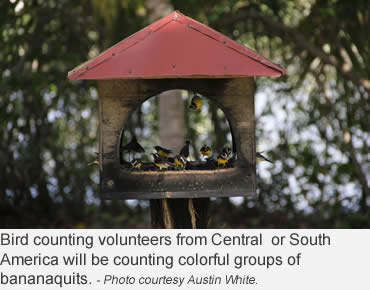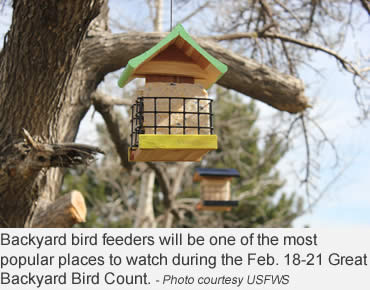It’s time to get ready for the 2022 Great Backyard Bird Count (GBBC) Feb. 18 through Feb. 21—a fun and free way to spend the late days of winter and become a citizen scientist.
Most importantly, it’s a way for novice and experienced birdwatchers to help scientists get a real-time snapshot of bird populations across the world from back yards, parks, playgrounds or any advantageous spot for birdwatching.
The Great Backyard Bird Count first was held in the U.S. and Canada during February to create a snapshot of the distribution of birds before spring migrations increase in March.
Scientists at the Cornell Lab of Ornithology, National Audubon Society, Birds Canada and elsewhere combined the information with data from surveys conducted at different times of the year. But, in 2013, the count went global, creating snapshots of where birds are located in February, regardless of seasons across the hemispheres.
In 2021, people from 184 nations participated in the annual four-day event, now in its 25th year.
 Last year was also the first year more than a million eBird checklists were submitted each month. On Global Big Day last May, a record-setting 52,000 birders reported 7,234 species on 133,000 checklists. On October Big Day 33,000 global birders reported 7,269 species from 195 countries—more countries birding on a single day than ever before. The next Global Big Day is May 14, 2022.
Last year was also the first year more than a million eBird checklists were submitted each month. On Global Big Day last May, a record-setting 52,000 birders reported 7,234 species on 133,000 checklists. On October Big Day 33,000 global birders reported 7,269 species from 195 countries—more countries birding on a single day than ever before. The next Global Big Day is May 14, 2022.
During last May, more than 28,000 eBirders submitted over 1 million bird photos and 5,000 recordists submitted more than 50,000 bird recordings.
Participating in the February Great Backyard Bird Count is simple.
Volunteer bird counters are asked to count birds for as little as 15 minutes on one or more days of the four-day event and then report their sightings online at birdcount.org.
Anyone from anywhere in the world can participate in the Great Backyard Bird Count.
The basics of preparing to participate are simple.
 You’ll need access to a bird identification book and the internet. (Libraries and schools offer free internet if you don’t have access at home.) Using the Merlin Bird ID Bird Identification app will be helpful for new bird watchers and those using a phone or tablet to identify birds. The Merlin app is easily downloaded for Android or iPhones.
You’ll need access to a bird identification book and the internet. (Libraries and schools offer free internet if you don’t have access at home.) Using the Merlin Bird ID Bird Identification app will be helpful for new bird watchers and those using a phone or tablet to identify birds. The Merlin app is easily downloaded for Android or iPhones.
Binoculars are optional, but helpful, and you’ll also need a notepad to record the birds you’ve seen. At the end of the count, share all your sightings and submit your recorded information online.
Those interested in joining the GBBC can register for a free webinar Feb. 16 to see what is involved and how to submit their bird sightings. Join experts online to brush up on bird ID, unlock the mystery of bird songs, and practice counting birds no matter how large the flock or busy the feeder.
The webinar is designed for birders of all ages and experience. Click here for more information or to sign up.
Ready, set, go count!